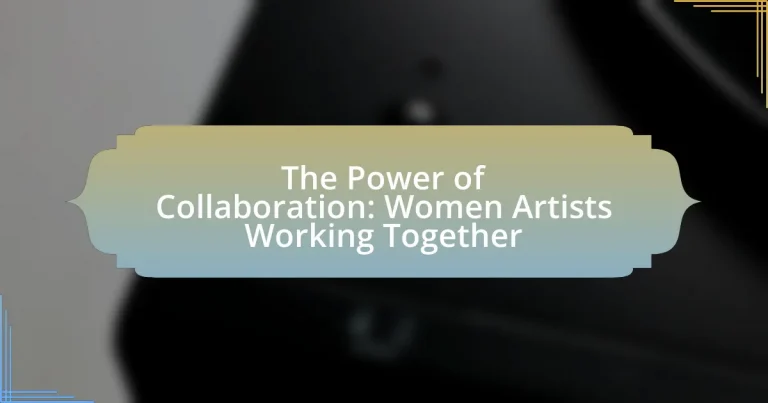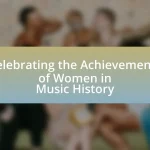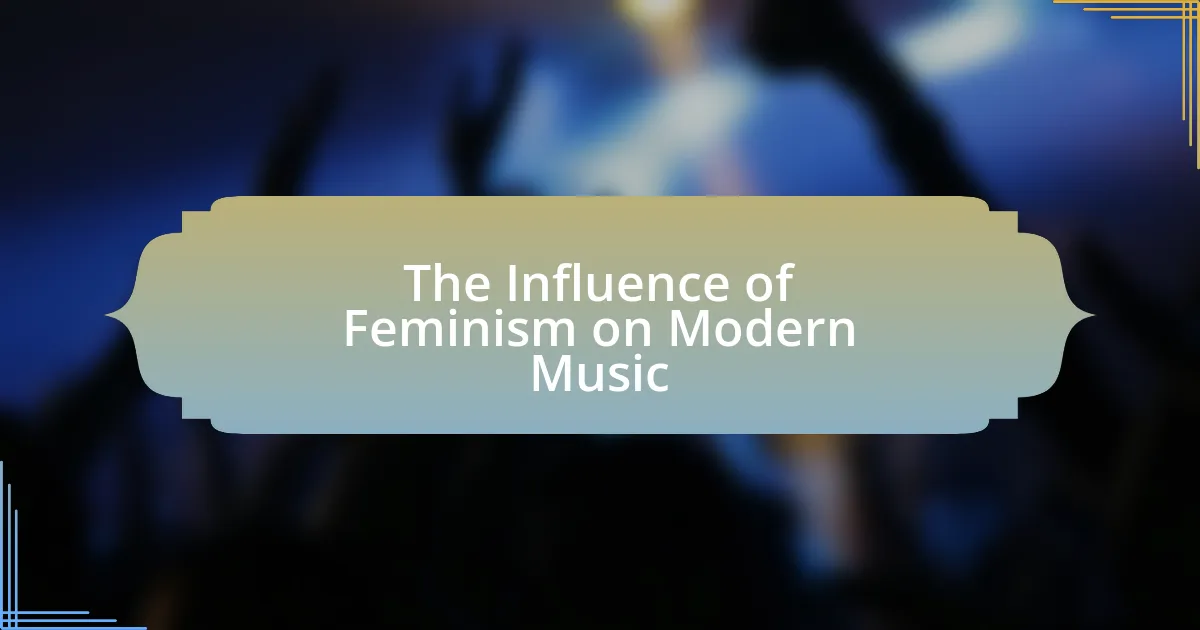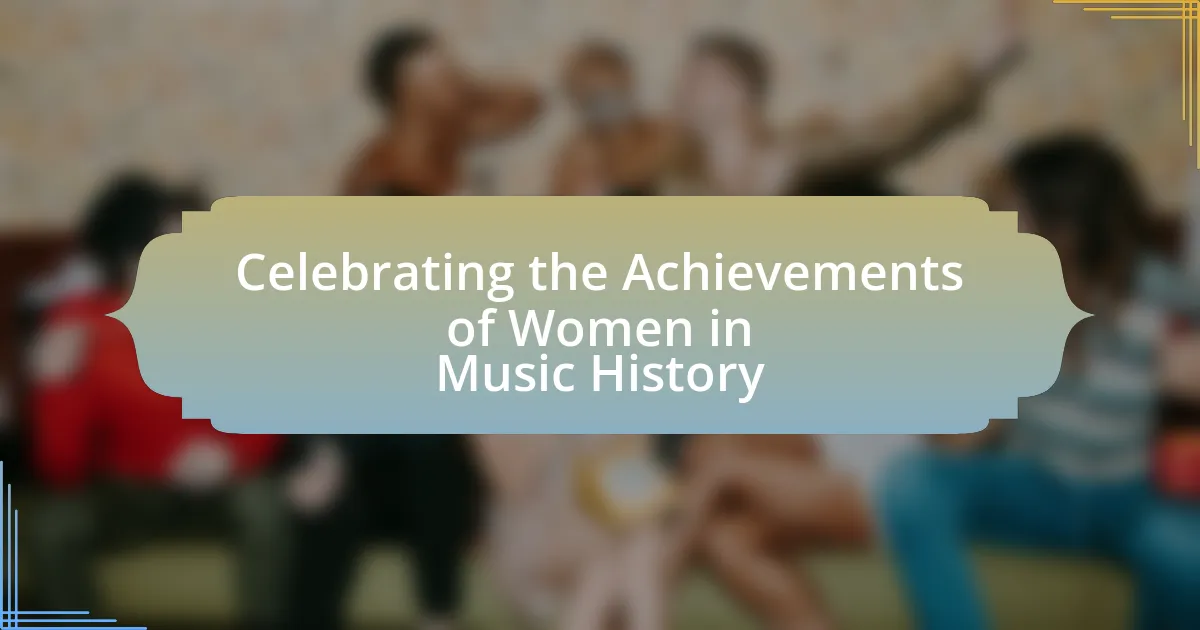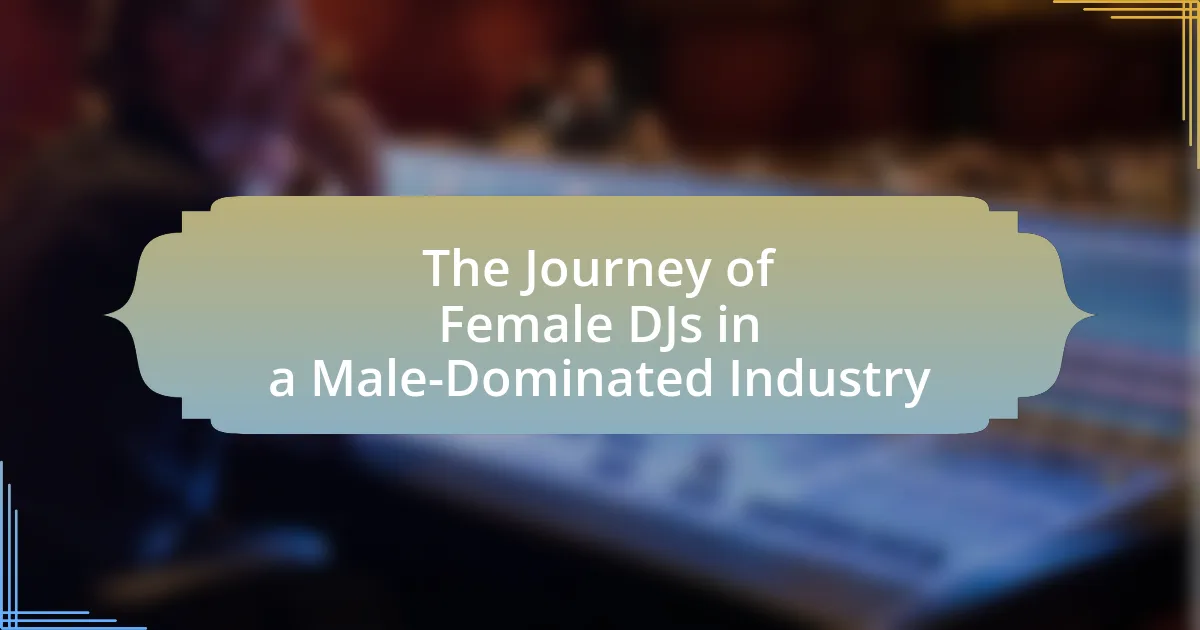The article “The Power of Collaboration: Women Artists Working Together” explores the significance of collaboration among women artists, emphasizing its role in fostering creativity, enhancing visibility, and addressing gender biases in the art world. It discusses how collaborative efforts lead to innovative artistic expressions and provide psychological benefits, such as increased confidence and emotional well-being. The article highlights historical barriers faced by women artists, notable collaborative projects, and the importance of supportive networks and resources that facilitate collaboration. Additionally, it outlines strategies for effective collaboration, potential challenges, and available funding opportunities for women artists engaging in joint artistic endeavors.
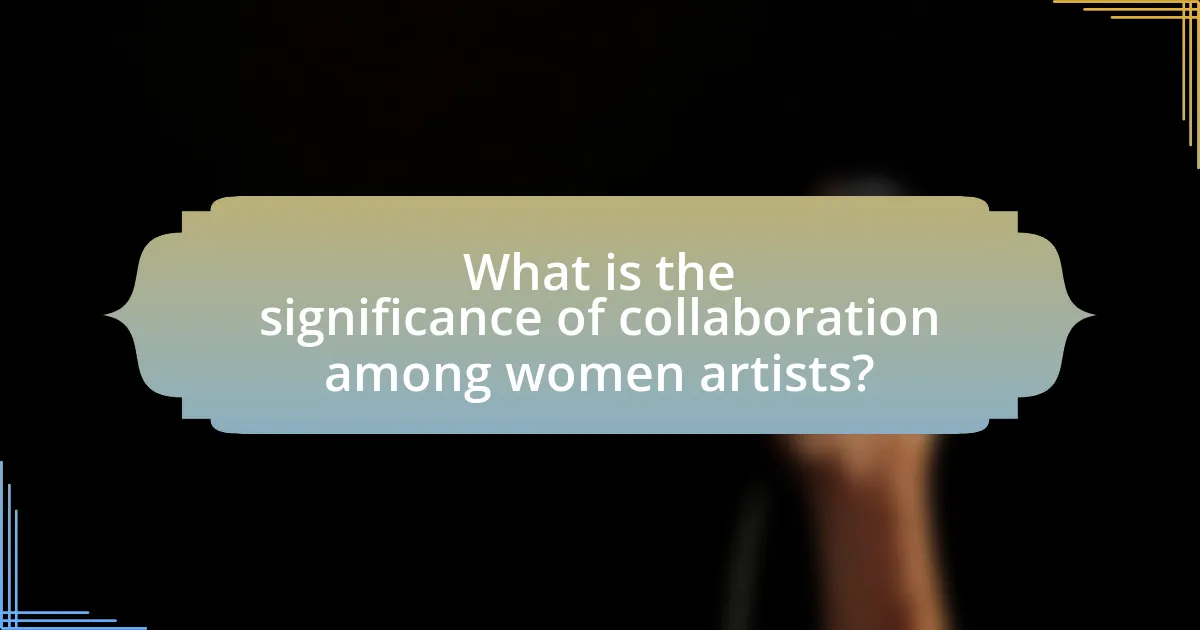
What is the significance of collaboration among women artists?
Collaboration among women artists is significant because it fosters a supportive environment that enhances creativity and amplifies their collective voices. This collaborative approach allows women artists to share resources, ideas, and experiences, which can lead to innovative works that challenge societal norms and promote gender equality in the art world. Historical examples, such as the Guerrilla Girls, demonstrate how collaboration can effectively address issues of representation and discrimination in the arts, highlighting the importance of solidarity among women artists in advocating for change.
How does collaboration enhance creativity in art?
Collaboration enhances creativity in art by combining diverse perspectives and skills, leading to innovative ideas and unique artistic expressions. When artists work together, they share their individual experiences and techniques, which can inspire new approaches and solutions that may not emerge in solitary practice. For instance, a study published in the Journal of Creative Behavior found that collaborative groups often produce more original and varied outcomes compared to individuals working alone, as the interaction fosters a dynamic exchange of ideas. This synergy not only broadens the creative process but also encourages risk-taking and experimentation, essential components for artistic growth.
What are the psychological benefits of working together for women artists?
Working together provides significant psychological benefits for women artists, including enhanced creativity, increased confidence, and improved emotional well-being. Collaborative environments foster a sense of community and support, which can alleviate feelings of isolation often experienced in the art world. Research indicates that collaboration can lead to greater innovation, as diverse perspectives stimulate new ideas and approaches. Additionally, women artists who collaborate report higher levels of self-esteem and motivation, as shared experiences and mutual encouragement reinforce their artistic identities. Studies have shown that social support networks are crucial for mental health, and collaboration creates these networks, ultimately contributing to a more positive and fulfilling artistic practice.
How does collaboration lead to innovative artistic expressions?
Collaboration leads to innovative artistic expressions by combining diverse perspectives, skills, and ideas, which fosters creativity and experimentation. When artists work together, they can challenge each other’s viewpoints and push the boundaries of their individual practices, resulting in unique and groundbreaking works. For instance, the collaborative projects of women artists, such as the Guerrilla Girls, have effectively highlighted social issues through innovative visual art, merging activism with creativity. This synergy not only enhances the artistic process but also broadens the impact of the artwork, as seen in exhibitions that feature collective works, which often attract wider audiences and provoke deeper discussions.
Why is collaboration particularly important for women in the arts?
Collaboration is particularly important for women in the arts because it fosters a supportive network that enhances visibility and opportunities. Women artists often face systemic barriers, including underrepresentation and lack of access to resources, which collaboration can help mitigate by pooling talents, sharing resources, and amplifying each other’s voices. Research indicates that collaborative projects among women artists lead to increased exhibition opportunities and greater recognition in the art world, as seen in initiatives like the Guerrilla Girls, who have successfully highlighted gender disparities in the art industry through collective action.
What historical barriers have women artists faced in solo endeavors?
Women artists have historically faced significant barriers in solo endeavors, primarily due to systemic gender discrimination and societal norms that marginalized their contributions. For instance, during the Renaissance, women were often excluded from formal art training and professional networks, limiting their opportunities to exhibit and sell their work. Additionally, the art market has historically favored male artists, with institutions like galleries and museums predominantly showcasing male talent, which further hindered women’s visibility and recognition. According to a study by the National Museum of Women in the Arts, only 11% of artists represented in major U.S. museums are women, highlighting the ongoing disparities in representation and support for women artists.
How does collaboration help in overcoming gender biases in the art world?
Collaboration helps in overcoming gender biases in the art world by fostering inclusive environments where diverse perspectives are valued and amplified. When women artists work together, they create networks that challenge traditional power dynamics and provide support systems that enhance visibility and opportunities. For instance, initiatives like the Guerrilla Girls have successfully highlighted gender disparities in the art market, demonstrating that collective action can lead to greater awareness and change. Additionally, studies show that collaborative projects often result in increased representation of women in exhibitions and galleries, thereby directly addressing the historical underrepresentation of female artists.
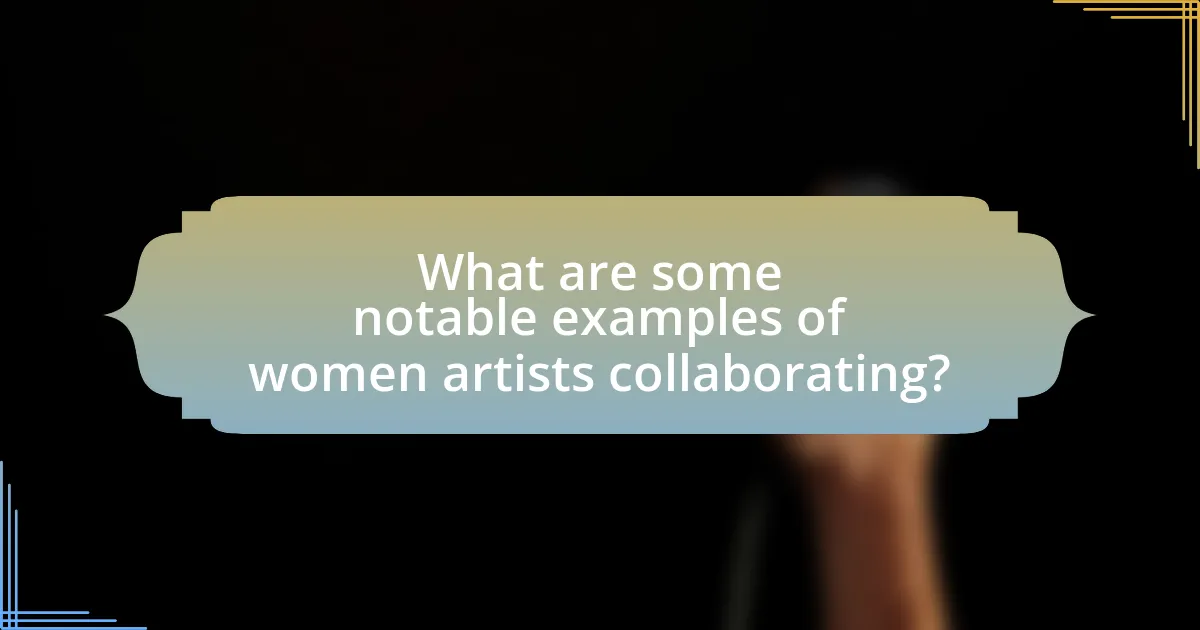
What are some notable examples of women artists collaborating?
Notable examples of women artists collaborating include the collective known as the Guerrilla Girls, who use art and activism to address gender and racial inequality in the art world. Another significant collaboration is between artists Judy Chicago and Miriam Schapiro, who co-founded the feminist art program at the California Institute of the Arts in the 1970s, promoting women’s contributions to art. Additionally, the duo of artists Ann Hamilton and Jennifer Allora have collaborated on various projects that explore themes of culture and identity. These collaborations highlight the impact of women artists working together to challenge societal norms and create meaningful dialogue through their art.
Which collaborative projects have gained recognition in the art community?
Collaborative projects such as “The Dinner Party” by Judy Chicago and “The Guerrilla Girls” have gained significant recognition in the art community. “The Dinner Party,” created in the late 1970s, features a triangular table with place settings for 39 notable women in history, symbolizing women’s contributions to culture and history. The Guerrilla Girls, an anonymous group of feminist artists, use provocative posters and public actions to address gender and racial inequality in the art world, gaining acclaim for their impactful activism. Both projects exemplify the power of collaboration among women artists, highlighting their collective voice and influence in contemporary art.
What themes are commonly explored in these collaborative works?
Common themes explored in collaborative works by women artists include empowerment, identity, community, and social justice. These themes reflect the shared experiences and challenges faced by women, emphasizing the importance of collaboration in fostering a supportive environment. For instance, many projects focus on the intersectionality of gender, race, and class, highlighting how these factors influence women’s lives and artistic expressions. Additionally, collaborative works often address issues such as environmental sustainability and mental health, showcasing the collective voice of women in advocating for change.
How have these collaborations influenced the careers of the artists involved?
Collaborations among women artists have significantly enhanced their visibility and career trajectories. By working together, these artists have created a supportive network that fosters creativity and innovation, leading to increased recognition in the art world. For instance, collaborative projects often result in exhibitions that attract larger audiences, thereby elevating the profiles of all participating artists. Additionally, partnerships can lead to shared resources, such as funding and marketing, which are crucial for career advancement. Evidence of this impact can be seen in initiatives like the Guerrilla Girls, whose collective efforts have brought attention to gender inequality in the art industry, ultimately benefiting the individual careers of its members through heightened public awareness and critical acclaim.
What platforms exist for women artists to collaborate?
Platforms that exist for women artists to collaborate include ArtGirlRising, a community that connects female artists for projects and exhibitions, and The Creative Women’s Network, which fosters collaboration through events and online resources. Additionally, platforms like Women’s Studio Workshop provide grants and residencies specifically for women artists, encouraging collaborative projects. These platforms support networking, resource sharing, and joint artistic endeavors, thereby enhancing visibility and opportunities for women in the arts.
How do art collectives support collaborative efforts among women artists?
Art collectives support collaborative efforts among women artists by providing a platform for shared resources, networking, and collective visibility. These collectives often facilitate workshops, exhibitions, and projects that encourage collaboration, allowing women artists to pool their talents and ideas. For instance, organizations like the Guerrilla Girls and the Women’s Caucus for Art have historically created spaces where women can collaborate on projects that challenge gender norms in the art world. This collaborative environment not only fosters creativity but also amplifies the voices of women artists, making their work more accessible to broader audiences.
What role do social media and online communities play in facilitating collaboration?
Social media and online communities play a crucial role in facilitating collaboration by providing platforms for communication, resource sharing, and networking among individuals. These digital spaces enable artists to connect with peers, share their work, and collaborate on projects regardless of geographical barriers. For instance, platforms like Instagram and Facebook allow women artists to showcase their art, receive feedback, and engage in discussions, fostering a sense of community and support. Research indicates that 70% of artists report increased collaboration opportunities through social media, highlighting its effectiveness in building networks and partnerships.
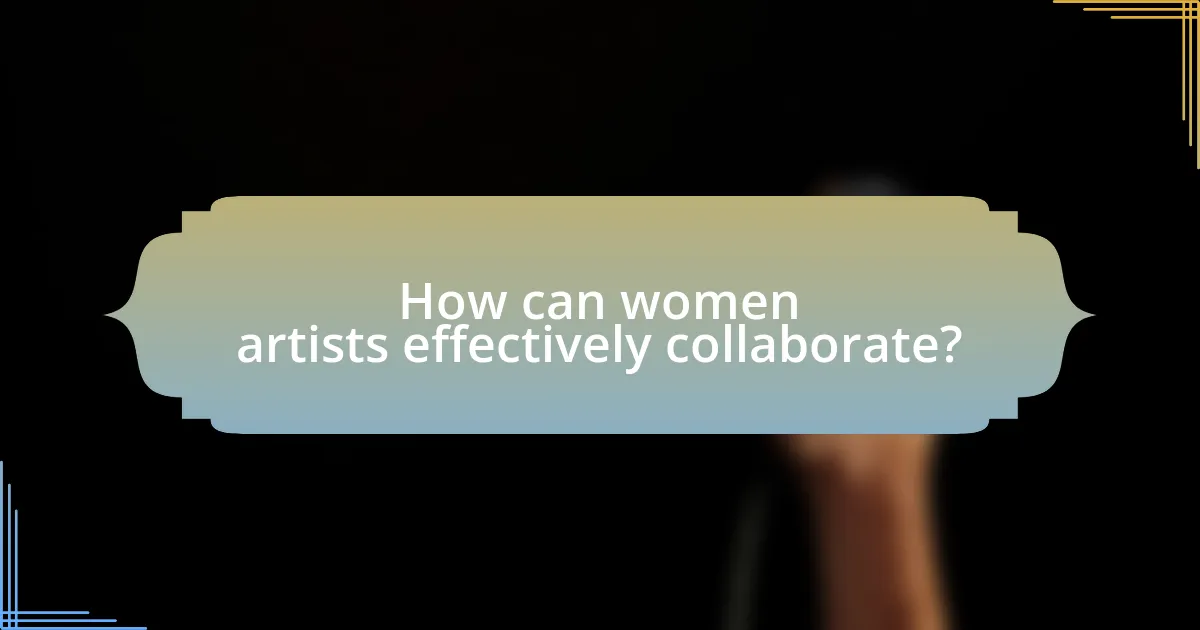
How can women artists effectively collaborate?
Women artists can effectively collaborate by establishing clear communication, setting shared goals, and leveraging each other’s strengths. Clear communication fosters understanding and minimizes misunderstandings, while shared goals align the artists’ visions and efforts. By recognizing and utilizing each other’s unique skills, such as technical abilities or creative perspectives, women artists can enhance the quality and impact of their collaborative projects. Research indicates that collaboration among women artists can lead to increased visibility and opportunities, as seen in initiatives like the Guerrilla Girls, which successfully raised awareness about gender inequality in the art world through collective action.
What strategies can enhance successful collaboration among women artists?
Successful collaboration among women artists can be enhanced through establishing supportive networks, fostering open communication, and creating shared goals. Supportive networks provide a foundation for collaboration by connecting women artists with mentors and peers, which can lead to increased opportunities and resources. Open communication encourages the sharing of ideas and constructive feedback, essential for creative growth and collaboration. Additionally, setting shared goals aligns the efforts of collaborating artists, ensuring that all participants are working towards a common vision, which can lead to more cohesive and impactful projects. These strategies are supported by research indicating that collaborative environments significantly boost creativity and innovation among artists.
How can clear communication improve collaborative projects?
Clear communication enhances collaborative projects by ensuring that all team members understand their roles, responsibilities, and objectives. When artists collaborate, effective communication fosters a shared vision, minimizes misunderstandings, and promotes a cohesive workflow. Research indicates that teams with strong communication practices are 25% more productive, as they can quickly address issues and adapt to changes. This is particularly relevant in collaborative art projects, where diverse perspectives must be integrated seamlessly to achieve a unified outcome.
What are the best practices for setting goals in collaborative art projects?
The best practices for setting goals in collaborative art projects include establishing clear communication, defining roles and responsibilities, and setting measurable objectives. Clear communication ensures that all participants understand the project’s vision and expectations, which fosters a collaborative environment. Defining roles and responsibilities helps to clarify each artist’s contributions, reducing overlap and confusion. Setting measurable objectives allows the team to track progress and assess the project’s success, ensuring that all members remain aligned with the project’s goals. These practices are supported by research indicating that effective collaboration enhances creativity and productivity in artistic endeavors.
What challenges might arise during collaboration, and how can they be addressed?
Challenges during collaboration among women artists may include communication barriers, differing artistic visions, and power dynamics. To address communication barriers, establishing clear channels and regular check-ins can facilitate understanding. Differing artistic visions can be reconciled through compromise and open discussions about each artist’s goals. Power dynamics can be mitigated by fostering an inclusive environment where all voices are valued, ensuring equitable participation in decision-making processes. These strategies promote effective collaboration and enhance the creative output of the group.
How can conflicts be resolved in collaborative settings?
Conflicts in collaborative settings can be resolved through open communication, active listening, and establishing common goals. Open communication allows all parties to express their concerns and perspectives, which fosters understanding. Active listening ensures that each participant feels heard and valued, reducing tensions. Establishing common goals aligns the group’s efforts and encourages collaboration towards a shared outcome. Research indicates that teams that engage in these practices experience a 25% increase in conflict resolution effectiveness, as highlighted in the study “Conflict Resolution in Collaborative Teams” by Johnson and Johnson, published in the Journal of Conflict Resolution.
What are common pitfalls to avoid in collaborative art projects?
Common pitfalls to avoid in collaborative art projects include lack of clear communication, unequal participation, and differing artistic visions. Clear communication is essential to ensure all collaborators understand their roles and expectations; without it, misunderstandings can lead to frustration and conflict. Unequal participation often results in resentment, as some members may feel overburdened while others contribute less. Additionally, differing artistic visions can create discord if collaborators do not align their goals and aesthetics from the outset. Addressing these issues proactively can enhance the collaborative process and lead to a more successful outcome.
What resources are available for women artists looking to collaborate?
Women artists can access various resources for collaboration, including organizations, online platforms, and grants specifically designed to support their creative partnerships. Notable organizations such as the Women’s Caucus for Art provide networking opportunities and resources tailored for women artists. Online platforms like ArtConnect and Collaborate offer spaces for artists to connect and collaborate on projects. Additionally, grants from institutions like the National Endowment for the Arts often prioritize collaborative projects among women artists, providing financial support to facilitate their work together. These resources collectively enhance opportunities for women artists to engage in meaningful collaborations.
How can workshops and mentorship programs facilitate collaboration?
Workshops and mentorship programs facilitate collaboration by creating structured environments where individuals can share knowledge, skills, and experiences. These settings encourage interaction among participants, fostering relationships that enhance teamwork and collective problem-solving. For instance, a study by the National Endowment for the Arts found that collaborative workshops significantly increase participants’ ability to generate innovative ideas and solutions, demonstrating the effectiveness of such programs in promoting cooperative efforts.
What funding opportunities exist for collaborative projects among women artists?
Funding opportunities for collaborative projects among women artists include grants from organizations such as the National Endowment for the Arts, which supports collaborative artistic endeavors. Additionally, the Women’s Studio Workshop offers funding specifically for women artists working together on projects. The Puffin Foundation also provides grants for collaborative art initiatives that promote social change, often favoring projects led by women. These funding sources are designed to empower women artists and facilitate their collaborative efforts, thereby enhancing visibility and support for their work.
